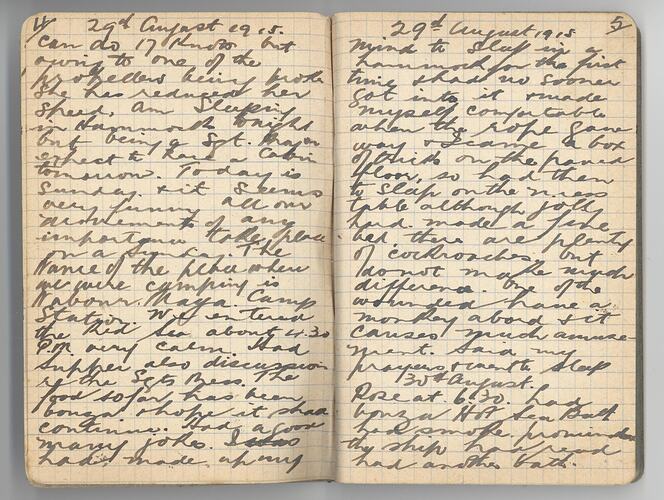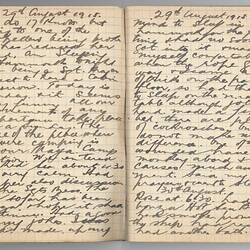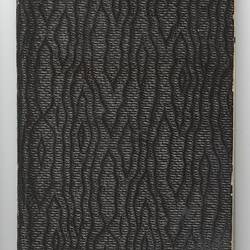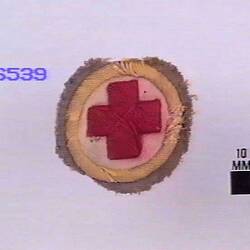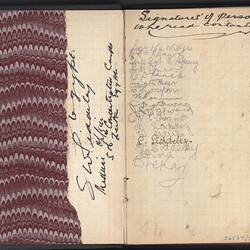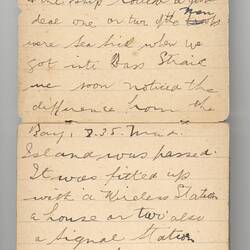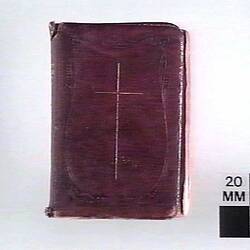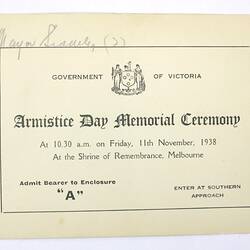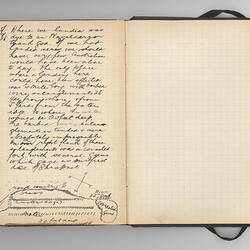Summary
Cardboard-covered third volume of a diary written by Corporal S.W. Siddeley. The diary consists of three notebooks, written between October 1914 and September 1915. It covers the first convoy, the landing of the Anzacs at Gallipoli and the campaign there. The diary contains graphic details of the landing at Gallipoli and the wounds of many, and Siddeley's work in a field hospital on the peninsula.
This volume is primarily about Siddeley's return voyage from Cairo, Egypt to Fremantle, Western Australia aboard S.S. Euripidies, from the 29th August 1915 until the 23rd September 1915.
On board Siddeley details every day life, from food, hammocks and salt water baths, to recreation such as Bridge games and the health and deaths of fellow soldiers on board. Siddeley is in a state of recovery, catching up on sleep and writing (briefly) of a worsening heart condition and strong headaches.
The latter section of the diary has been used for quick notes to himself, detailing pharmaceutical scripts and medical supplies (often in shorthand with some latin), pay and expenses, and addresses of friends and people that he met.
This volume also includes a sketch of the Gallipoli Penninsula and Anzac Landing, pg. 27, and a poem about trench life, (not written by Siddeley, author unknown, p. 23). This extract describes his final departure from camp in Cairo: '...Went to camp and said goodbye to all my pals, which are only a few, the majority of my pals are all dead and buried. Norm Cook of St. Kilda, he gave me a hand with my two kit bags before we said Au Revoir. I gave him my spurs. It was sad for both of us, both being the oldest pals' (p. 1.)
Physical Description
Hand-written diary bound in cardboard covered with black paper. Printed with vertial and horizontal lines. Writing is principally in ink. Includes a sketch of Shrapnel Gully.
Significance
Personal diaries provide a valuable insight into the daily life in the Australian armed forces. Some diarists record the mundane routines of daily life in military camps, or ports visited during voyages on transport ships; others provide graphic details of battles and medical treatments. Welcome letters and parcels from home are described, and friendships are recorded. Many soldiers complain about the food, or record welcome or festive meals such as Christmas. The diaries show many of the ways servicemen and women coped with the discipline, stress and tragedy of war.
More Information
-
Collection Names
Military Memorabilia Collection, Returned and Services League (RSL) Collection
-
Collecting Areas
Home & Community, Medicine & Health, Public Life & Institutions
-
Acquisition Information
Donation & Subsequent Transfer from Victorian Branch, Returned & Services League of Australia Limited (RSL), Mrs Ethel C. Siddeley, Oct 1984
-
Author
Corporal S. W. Siddeley - Australian Imperial Force (AIF), 1915
-
Place Made
-
Place Made
-
Inscriptions
[Extensive hand-written text]
-
Classification
-
Category
-
Discipline
-
Type of item
-
Overall Dimensions
8.5 cm (Width), 0.8 cm (Depth), 13 cm (Height)
-
References
National Archives of Australia hold enlistment and other papers relating to Siddeley - Series number B2455, Barcode 8083551. Further information on Siddeley's diary is available on Museum Victoria's Imagining Australia 1914-1918 web site at [Link 1] National Archives of Australia also hold Department of Veteran's Affairs Repatriation Department Medical files and Hospital files on Siddeley, post-war, Series number B73/51, Barcode 12848064, and B73, 12848204.
-
Keywords
Psychiatric Patients, Wars & Conflicts, World War I, 1914-1918, Making History - War Diaries and Correspondence
